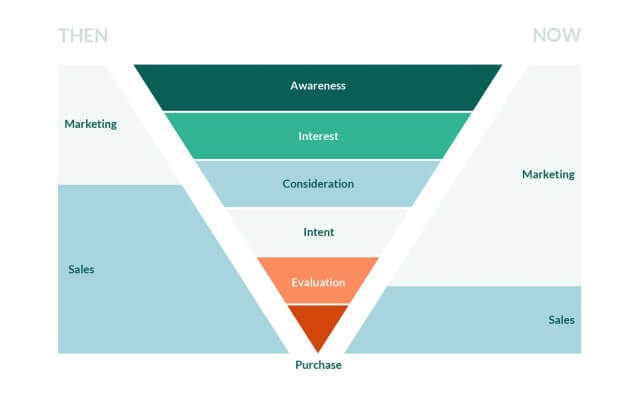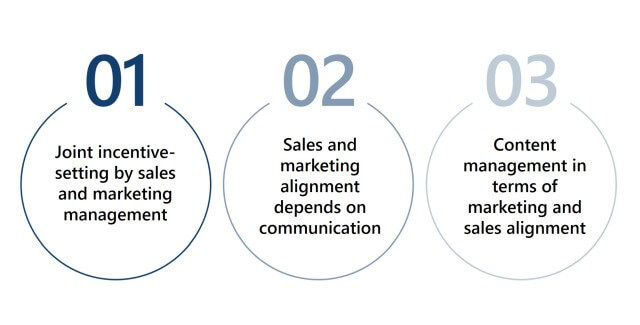Sales and marketing alignment - high time for a joint venture!
Marketing and sales are two fundamental departments that aim for the same goal: to attract and retain customers. Even so, in many companies the relationship between those teams is characterized by a lack of understanding, mistrust, or even dislike. That leads to an average of 65% of marketing content not being used and around 70% of leads not landing a sale. With sales and marketing aligned, those problems disappear.
Why a rethink in sales and marketing management must take place, and how to achieve a sales and marketing alignment, are the focus of this blog post.
What is sales and marketing alignment?

Alignment means coordination. So sales and marketing alignment involves integrating sales and marketing into a "smarketing" team. Sales and marketing alignment generates closer collaboration, greater transparency, better communication, and more effectiveness. That results in more customers, more leads, more sales, and more company revenue. The joint alignment of sales and marketing can - but does not have to - result in a merger of the two departments. The main thing is to pull together.
Why is sales and marketing alignment often so tricky?
Collaboration between sales and marketing can be quite challenging because those two closely related departments have different priorities:
- Sales teams focus on closing immediate deals with direct customers. They can measure success immediately.
- Marketing teams, on the other hand, look further into the future and direct their efforts toward their target audiences. Success is not so easy to measure due to a lack of measurement methods, usually over longer periods of time.
Both approaches are absolutely understandable. However, those different ways of thinking mean that sales and marketing often work at cross purposes or - in the worst case - even against each other.

A rethink must take place with regard to the marketing and sales funnel. Where sales a few years ago still acted according to the motto "ABC - always be closing" and was successful with it, today it is much more likely to be part of a marketing mix. Customer behavior has changed completely as part of the digital revolution. In other words, the sales-heavy funnel of yesteryear has evolved into a marketing-sales funnel.
New Sales and Marketing Funnel

(source: Superoffice)
The symbiosis between sales and marketing
There are various approaches to promoting cooperation between sales and marketing. We would like to present the most important ones in more detail.
- Joint incentive-setting by sales and marketing management
In order for both departments to work together in one direction, they must have the same incentives. Among the most obvious incentives are, for example, bonus payments linked to sales performance. But where sales successes can easily be measured, it is much more difficult for marketing. After all, marketing is measured by the scope of its activities, not by direct sales. So it is necessary to make the value of marketing activities tangible for sales and thus for company revenue.
This is where measurement methods such as the linking of marketing and sales data (closed loop reporting) come into play. They make the contribution of marketing to sales measurable, which enables aligning the marketing incentive system with that of the sales team. - Sales and marketing alignment depends on communication
Smarketing requires communication between the two teams. Sales and marketing must work together to create a marketing and sales funnel that aligns with the company’s mission and the motivations of its target audiences.
For example, everyone needs clarity about when a lead created by marketing is passed on to sales. Or when sales hands over a lead to marketing for nurturing.
This creates numerous win-win situations:
- Marketing can measure success based on the leads they generate.
- Sales gets better leads they can more easily convert to customers.
- The teams‘ collaboration constantly improves through ongoing communication.
- More effective customer communication takes place.
- Marketing campaigns can be more sales-oriented.
- Marketing content can also be used for sales campaigns. - Content management in terms of marketing and sales alignment
Content produced by marketing is usually only used by marketing. Often the sales team either does not have access to the content created or does not even know it exists. Yet there is an incredible amount of potential in jointly creating and using of content for customer acquisition, customer retention, and increased sales.
Consistent appearance of the corporate design
It is therefore important to make content easier to find. Content must be clearly categorized (e.g., touchpoints within the marketing and sales funnel, industries, buyer personas, etc.). It is equally important to be able to edit content simultaneously and independent of location, and to present a consistent appearance of the corporate design on all documents, e-mail signatures, and templates.
At first, this content management aspect of marketing-sales alignment sounds like a considerable change of systems and structures for the marketing team. The MS Office add-in suite from empower® offers a simple solution that implements quickly and integrates with existing applications such as DAM, PIM, Teams and SharePoint.
Should your interest in empower® be aroused, then arrange a free consultation appointment.
You May Also Like
Related articles

Marketing Automation Spotlight: Definition, Benefits, Implementation

The Top MarTech Tools of today
